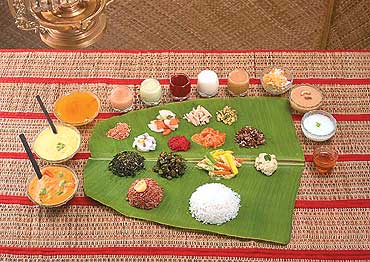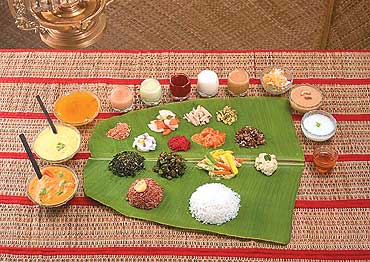6TH TRADITIONAL FOOD FESTIVAL
(6th to 8th December, 2008)
“A cultural milieu to revive the forgotten tastes and hence the forgotten ties!”
Date : 6th to 8th December, 2008
Venue : New Campus, IIM, Vastrapur, Ahmedabad
Time : 11.00 am to 10.00 pm

Report
Sixth Annual Traditional Food Festival to celebrate culinary creativity along side the agro- biodiversity, that too maintained often without using chemical inputs, – Satvik 08 was organized by Honey Bee Network at IIM Ahmedabad Campus from 6th to 8th December. Aromas and smiles welcomed visitors to the confluence of consumers and farmers. With 57 stalls offering diverse cultures and tastes, people could not have asked for a bigger menu to tickle the taste buds and tinkle the brains.
The festival was inaugurated by Prof B H Jajoo, the Acting Director of IIM Ahmedabad. Farmers from Kutch, Jasdaan, Surendranagar, Panchmahal and many other pats of the country attended the opening with grins and garnishings for the visitors.
The winners of the SRISTI traditional recipe contest were also awarded on the occasion.
Esther David (Times of India columnist) personally welcomed the visitors to the Jewish stall, set up for the first time in Satvik. She told that the Jews have strict dietary norms that often make them use coconut milk as substitute to the dairy products. Some of their festive fares like Kippur (Day of Atonement, better known as Yom Kippur) chi puri, oil free poha with coconut, raisins and nuts, badam chi pez, date sheera, black currants sherbet and ‘falafal’ have been Indianised.
Tribal and Rural Fare
The farmers from the different villages in Gujarat put up 25 food stalls. Their mouth watering recipes like Bajra no rotlo (millet bread), ringan no sag (aubergine gravy), chat (spicy starters), seven grains khichdi, basil (Ocimum americanum) preparation, ‘sheero’ (Indian pudding) uniquely made of bamboo seeds acted as major drawers. The visitors enjoyed many additional recipes from the tribal areas of Gujarat like dumplings made from local corn and laddoo (bolus) of bavta and mahua flowers, bhaji (gravy) of gram pulse leaves, etc.
The North East India was animated through the Chutney made of Bamboo, also called Toko Toko Patta and steamed rice in leaves at Arunachal Pradesh stall. Mushtaq, an apple cum walnut cultivator and also an innovator from Jammu and Kashmir was welcoming the visitors with ‘Keheva’, Kashmiri tea made from saffron. From Bagpat, UP, there were nutritious as well as tasty palak and papita ki barfi (sweet made from spinach and papaya).
The Prakriti Mahila Udyog, Ahmedabad drew countless visitors for its Natural Ice cream, sweetened with dry fruits only. James, a foreign national after tasting it, claimed that the Indian Ice cream was the best in the world.
Sandhya Mandal, Honeybee collaborator from West Bengal had date jaggery as a variety. The stall of Centre for Environment and Education, Ahmedabad was selling Nagli (a grain) powder and ‘papad’ (fritters) of pumpkin.
Arrays of juices like phindla (prickly pear) juice (good for Asthma, Hepatitis B), pumpkin, mint- ginger and drumstick juice quenched the thirst and aroused the curiosity of the visitors. ‘Adhar Charitable Trust’ an NGO, had a stall run by the HIV positive people. The crowd gathered at their stall to enjoy their tangy chaats. Bhakhri pizza, seven grains pizza and smoked chaas (buttermilk) were the Indian recipes refurbished in name and presentation to attract the health-conscious and youngsters.
The visitors happily shared their feelings. Mr & Mrs K N Dhingra, 60 years, were simply delighted at the concept of Traditional Food Festival. Saloni and Margi Parikh, young students from Nirma Institute were totally awed by this different picture of India. Emile and Sam, UK nationals living in Ahmedabad for a year now, were the happiest visitors around, beaming with the joy of aromatic spices, bought from the ‘haat’. James from England was carrying back five kg of rice home. He said that the Satvik Food Festival was an answer to the Genetically Modified food.
Consumer to Farmer: Khedut Haat - Farmers’ Fair
The farmers, engaged in organic farming had the opportunity of selling their products directly to the urban buyers. The visitors were delighted to find some uncommon grains from the tribal areas of Gujarat like old varieties of red rice, Krishna-kumud rice, local varieties of soyabean and minor millets like bawto, bunti, nagli and Black moong. Apart from the usual vegetables, the cocassia leaves and bulbs, drumstick, single-bulb garlic (good for heart), gooseberry, suran, ratalu were sold in good volume. The guava, cactus, tulsisudha, khatti bhindi and takmaria (basil plant seed) juices were prepared and sold by the farmers in the haat itself. Ramkrishna Hegde, a farmer from Karnataka brought cardamom, clover, nutmeg and also local coconut sweets for sale.
Some rare delicacies were only available at Satvik. They were banni ka mawa (a famous variety of mawa only made in deserts of Banni region in Kutchh, Gujarat), nagli ni sukhdi, kothumbura (cucumber) waffers, sharad saakar (sugar especially prepared in the moonlight on the Sharad Purnima). The visitors enjoyed the fresh chaas (buttermilk) of cow milk. Some interesting items for sale in the haat were black soil and goats’ droppings as fertilizer. Shilpa Mehta, a regular visitor for four years, remarked that she could never find things available here, in the outside markets. Swati Kachi wanted Food Festival to be extended by few more days.
Brain Teasers
NIF stall showcased various innovations like the amphibious bicycle, pedaled washing machine. Hiteshbhai Bhrambhatt and fellow teachers from Kheda Zilla Shikshan Samiti put up 47 puppet shows featuring the importance of education and environmental conservation. Ratilal Mandali, had on display 52 cards, umbrella, and snakes and ladders to teach Hindi, English and Maths.
Splashing the Creativity
The Satvik jostled with children’s activities throughout the three days. SRISTI had distributed 1,50,000 free passes to students. The talent hunt competitions like drawing and painting on theme of Satvik, innovative idea, dancing, singing , card-making, face painting and slogan writing contests kept the children engaged and entertained.
Vinay Mahajan, an IIM alumnus and Charul Bharwada, an architect, from ‘Loknaad’ touched everybody’s heart with the recital of songs on the issues of communal harmony, non-violence and the concern for common people.
Traditional Recipes
1. Theg nu Sheero (Pudding)
Theg is a so called weed found mainly in the Nalsarovar area near Ahmedabad. Take 250g of Theg. Grind it coarse. Roast it in 100g ghee, till it turns brown. Then add 100g jaggery and cook for a while. Let it cool and then garnish it with desiccated coconut and chopped almonds. Sprinkle cardamom powder.
SRISTI lab got the theg weed chemically analyzed and found it to be an extraordinary rich source of Calcium and many other nutrients. Market for theg will directly enhance income generating opportunities for some of the poorest people who collect this plant.
2. Baans nu Sheero (Bamboo Seeds Pudding)
Thresh the bamboo seeds mildly and let the skin come out. Grind the seeds coarsely. Roast 250g of bamboo seeds in 100g ghee till they turn brown and then add the jaggery. Let it cook for a while and then garnish it with the chopped almonds and cardamom powder.
3. Mahua ke Phool ke Laddoo
Sweet Bolus made from Madhuca longifolia (J.Konig ) J. F. Machr.
Mahua flowers are commonly found in the tribal areas in almost all the parts of the country. To make the laddoos take 500g of flowers and ground them till reduced to paste. Take 500g of wheat flour, add 75g of ghee and knead it hard. After making small balls of it, either make bhakri (cooked on clay tawa or griddle) or bati (roasted in oven/bhatthi/chulha). After the batis or bhakris cool, grind them coarsely, sieve to get the powdered form. Now add the mahua paste and 125g of ghee. Mix them properly and make the laddoo. (Honey Bee 19(4): 7-8, 2008).


